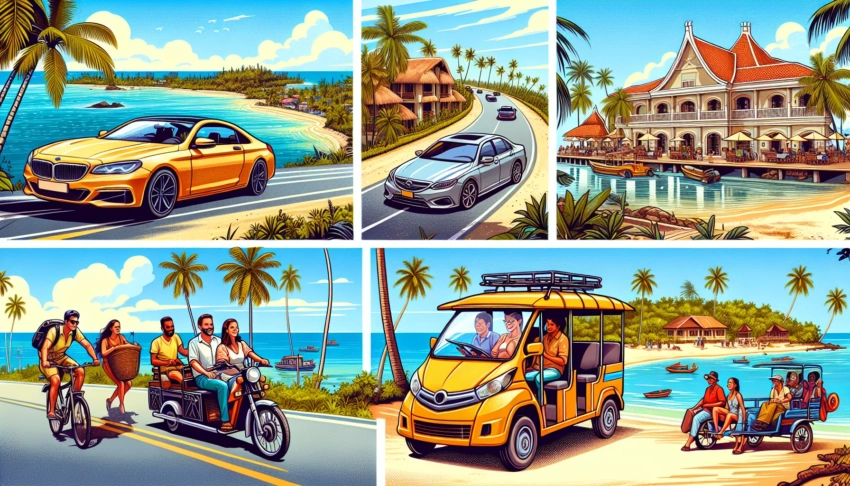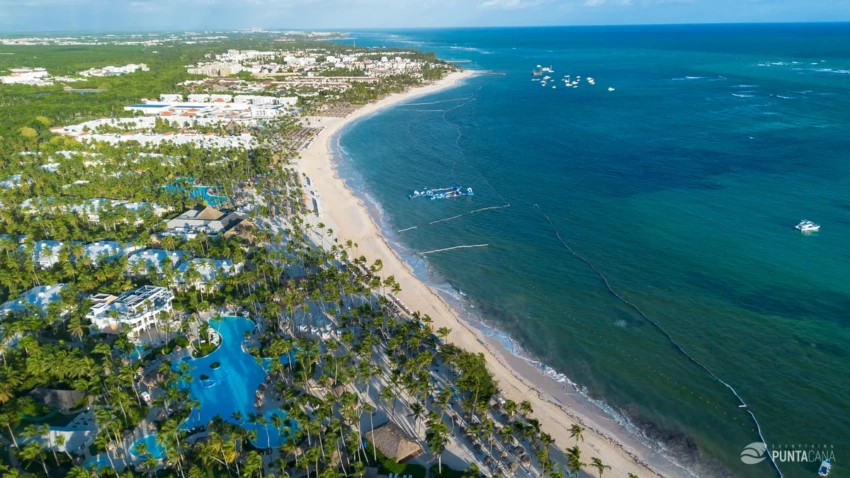Do You Need a Car When Staying in a Rental in Punta Cana?
Understanding Punta Cana’s Transportation Options

Do You Need a Car When Staying in a Rental in Punta Cana?
Navigating Punta Cana without a personal vehicle is not only feasible but can also be a delightful experience. Understanding the transportation options available can greatly enhance your stay, providing both convenience and an opportunity to immerse yourself in the local culture.
1. Public Transportation
Public transportation in Punta Cana is a viable option for those looking to explore the area without renting a car. The local bus system, known as “guaguas”, is the backbone of public transit. These buses are affordable and run on fixed routes connecting major points in the region, such as Bávaro, Higüey, and Verón.
The guaguas are often used by locals and provide an authentic glimpse into everyday life in the Dominican Republic. However, the schedule can be somewhat unpredictable, and buses might not always adhere to a strict timetable. It’s advisable to allow for flexibility in your schedule if you plan to rely on this mode of transport.
Public Transportation Options in Punta Cana
| Type | Routes | Reliability | Cost |
|---|---|---|---|
| Guaguas (Buses) | Major towns and local areas | Medium | Low |
| Motoconchos (Motorbike Taxis) | Short distances | High | Low |
2. Taxi Services
Taxi services in Punta Cana offer a more flexible and comfortable means of transportation compared to public buses. Taxis can be found at airports, major hotels, and shopping centers. They are a reliable option, especially for those traveling in groups or with heavy luggage.
While taxis provide door-to-door service, it’s important to be aware of the cost. Fares are not metered, so it’s imperative to negotiate the price before the trip begins. On average, a ride within the tourist areas can cost anywhere from $10 to $30, depending on the distance. Despite the higher cost, taxis offer convenience and a direct route to your destination without the wait times associated with public buses.
3. Car Rental Pros and Cons
Renting a car in Punta Cana can significantly enhance your travel experience, providing unmatched freedom and flexibility. It allows you to explore hidden gems and remote beaches that might be inaccessible by public transport. However, there are several factors to consider before making this decision.
The primary advantage of renting a car is the ability to create your itinerary without being constrained by public transportation schedules. It also offers privacy and the convenience of traveling on your own terms.
On the downside, renting a car comes with its own set of challenges. Navigating unfamiliar roads can be daunting, particularly if you’re not accustomed to the local driving style. Additionally, the cost of rental, insurance, fuel, and potential parking fees can add up quickly.
Pros and Cons of Renting a Car in Punta Cana
| Pros | Cons |
|---|---|
| Flexibility and freedom | Costly (rental, fuel, insurance) |
| Access to remote locations | Navigational challenges |
| Privacy | Parking issues |
Ultimately, whether or not you decide to rent a car in Punta Cana depends on your personal preferences and travel plans. By weighing the pros and cons, and considering the availability and convenience of alternative transportation options, you can make an informed decision that best suits your needs.
Exploring Punta Cana’s Attractions Without a Car
Punta Cana offers an enticing array of attractions that can be easily enjoyed without the hassle of renting a car. From its pristine beaches to cultural excursions, the area provides various options to explore its beauty using alternative transportation methods.

Aerial view of Punta Cana
1. Local Tours and Excursions
One of the most convenient ways to explore Punta Cana without a car is through local tours and excursions. Many tour operators offer comprehensive packages that include transportation, allowing you to relax and enjoy the journey. Popular destinations like Saona Island, Hoyo Azul, and the Indigenous Eyes Ecological Park are easily accessible through these guided tours.
These excursions not only cover transportation but also provide insightful guides who enrich your experience with their local knowledge.
Popular Local Tours in Punta Cana
| Tour Name | Destinations Covered | Included Amenities | Average Price |
|---|---|---|---|
| Saona Island Paradise | Saona Island, Natural Pools | Lunch, Drinks, Snorkeling Gear | $85 |
| Hoyo Azul Eco Adventure | Scape Park, Hoyo Azul | Guide, Park Entry | $129 |
| Cultural Heritage Tour | Altos de Chavón, Local Villages | Guide, Lunch | $90 |
2. Walking and Biking Opportunities
For those who prefer a more active approach, walking and biking offer wonderful ways to explore the local scenery and attractions. Punta Cana is home to several pedestrian-friendly areas, such as Bavaro Beach, where you can take a leisurely stroll along the coast. Additionally, the Punta Cana Resort and Club offers biking trails that weave through its lush landscapes, providing an eco-friendly option to explore the area.
Biking not only offers a sense of freedom but also allows for spontaneous exploration of hidden gems that are often missed when traveling by car. Local bike rental shops make it easy to obtain a bike for a day or longer, offering competitive rates and the chance to discover Punta Cana at your pace.
3. Using Ride-Sharing Apps
Ride-sharing apps like Uber have become a convenient alternative for travelers in Punta Cana. These services provide a flexible and often cost-effective solution for getting around without a car. With the ability to request a ride directly from your smartphone, you can enjoy the convenience of door-to-door service without the stress of navigating unfamiliar roads.
Though not as widely available as in major cities, Uber and other local ride-sharing services can be an excellent choice for short trips and spontaneous outings. It’s worth noting that these apps typically offer transparent pricing, so you know the cost upfront, helping you budget your travel expenses more effectively.
Our Best Villa Rentals in Punta Cana
Discover a selection of luxurious villas available for rent in Punta Cana, each offering unique amenities and exquisite views. These properties provide the perfect retreat after a day of exploring, ensuring your stay is comfortable and memorable.

Villa Agapi (Caleton Estates 57) - The Most Beautiful Ocean View Villa in Cap Cana
from $2150 night Read more
Exclusive Ocean View 5-Star Cap Cana Villa for Rent - Chef, Butler, Maid & Golf Cart
from $3450 night Read more
Private Villa at Puntacana Resort & Club for Rent - Pool, Jacuzzi, BBQ, Maid, Cinema Room
from $1569 night Read more
Modern & Stylish 4-BR Family-Friendly Villa Rental in a Quiet and Gated Community in Bávaro, Punta Cana
from $179 night Read moreBy embracing these transportation alternatives, you can enjoy all that Punta Cana has to offer without the need for a personal vehicle. Whether through guided tours, biking adventures, or the convenience of ride-sharing, the choice is yours to explore this tropical paradise in a way that suits your style and preferences.
Cost Comparison: Renting a Car vs. Alternative Transport
Choosing the right transportation mode in Punta Cana can significantly impact your travel experience and budget. This section explores the financial implications of renting a car versus relying on public and private transport options.
1. Rental Car Expenses
Renting a car in Punta Cana provides a level of freedom and flexibility that is unparalleled by other modes of transportation. However, it’s crucial to consider the associated expenses to make an informed decision.
Breakdown of Rental Car Costs
| Expense Type | Approximate Cost | Notes |
|---|---|---|
| Rental Fee | $40 – $70/day | Varies by car type and rental duration |
| Insurance | $10 – $30/day | Optional but recommended for peace of mind |
| Fuel | $4 – $6/gallon | Fuel prices can fluctuate |
| Security Deposit | $200 – $500 | Refundable upon safe return |
Insurance is a crucial consideration when renting a car. While some credit cards offer rental coverage, it’s wise to verify the extent of protection. Moreover, fuel costs can add up, especially if you plan to explore extensively.
2. Public and Private Transport Costs
If renting a car seems costly, using public or private transport might be a financially viable alternative. Here’s an overview of the costs involved:
– Buses: Affordable and widely used by locals, buses charge around $1 per ride. However, routes may not cover all tourist spots, necessitating alternative transport for certain destinations.
– Taxis: With fares starting at $10 for short distances, taxis are convenient but can become expensive over longer distances or multiple trips.
– Ride-Sharing Apps: Popular services like Uber offer competitive pricing, often cheaper than taxis, providing a middle ground between cost and convenience.
The combination of these options can provide comprehensive coverage of Punta Cana without the commitment of a rental car.
3. Hidden Fees and Considerations
While upfront costs are essential, don’t overlook hidden fees that can arise in either scenario.
– Rental Cars: Apart from obvious costs, additional charges like airport surcharges, young driver fees, and late return penalties may apply. Always read the rental agreement thoroughly.
– Public Transport: While generally predictable, occasional additional costs, such as peak-time surcharges for taxis, can occur. Furthermore, the inconvenience of waiting for public transport or ride-sharing can translate into time lost, which is an essential consideration for tourists on a tight schedule.
Ultimately, your choice will depend on your travel style, budget, and the specific experiences you seek in Punta Cana. By weighing these options, you can ensure a satisfying and cost-effective vacation.
Safety and Convenience Factors
When planning a trip to Punta Cana, weighing the safety and convenience of various transportation options is essential to ensure a smooth and enjoyable stay. Understanding local driving conditions, the accessibility of public transport, and parking can significantly influence your decision.
1. Driving Conditions and Road Safety
Driving in Punta Cana presents a unique set of challenges and opportunities. The road network in Punta Cana is generally well-maintained, especially in tourist-heavy areas. However, conditions can vary significantly in rural regions or less populated areas.
Traffic norms in Punta Cana may differ from what you’re accustomed to. Roads can be bustling, particularly during peak tourist seasons. It’s crucial to stay vigilant, as traffic signs may not always be as prominent or clear as those in the United States. Additionally, local drivers may exhibit driving styles that are more aggressive than what you might expect.
To enhance safety, consider these tips:
- Always wear your seatbelt and ensure all passengers do the same.
- Familiarize yourself with local traffic rules before driving.
- Avoid driving at night, as lighting can be poor in some areas.
- Consider renting a GPS or using a reliable navigation app to help navigate unfamiliar roads.
2. Convenience of Public Transport
Public transportation in Punta Cana offers a convenient alternative to driving. Buses and shared taxis, known locally as “guaguas”, are an affordable and relatively easy way to navigate the area. These services primarily connect main tourist spots, shopping centers, and local neighborhoods.
The convenience of public transport depends largely on your itinerary. If you plan to explore popular attractions or stay within urban areas, buses and guaguas can be a hassle-free option. However, for more remote destinations, public transport may not be as readily accessible, and schedules can be unpredictable.
For tourists, public transport can be an exciting way to immerse in local culture while saving money. It’s important to plan routes in advance and remain flexible with timings.
3. Parking and Accessibility
Parking availability is another key consideration when deciding whether to rent a car in Punta Cana. In densely populated areas and tourist hotspots, finding parking can be challenging and sometimes costly. Many resorts and hotels offer parking facilities for guests, but it’s worth verifying this ahead of time.
For attractions in remote areas, parking might be more accessible and convenient. However, popular beaches and tourist attractions often have limited parking spaces, leading to potential delays and added stress.
Parking and Accessibility Comparison
| Location Type | Parking Availability | Typical Costs | Accessibility |
|---|---|---|---|
| Urban Areas | Limited | $5 – $10 per day | Moderate |
| Resorts | Ample (for guests) | Free or included | High |
| Remote Attractions | Adequate | Free | Varies |
Considering these factors, the choice between renting a car and using other transportation methods depends on your specific needs and itinerary. For those who prioritize convenience and flexibility, a rental car might be the best option. Conversely, if you prefer cost-effective and culturally immersive experiences, public transportation could be the way to go. Ultimately, evaluating safety and convenience will guide you to the most suitable transportation choice for your Punta Cana adventure.
Environmental and Cultural Considerations
When deciding whether to rent a car while staying in Punta Cana, it’s important to weigh not only the practical aspects but also the environmental and cultural implications of your choice. Engaging with local transport options can offer a more meaningful and sustainable travel experience.

Aerial view of Punta Cana
1. Eco-Friendly Transport Options
Eco-conscious travelers might be interested in exploring sustainable transportation alternatives available in Punta Cana. Opting for such modes of transport not only reduces your carbon footprint but also supports global environmental conservation efforts.
Several hotels and resorts in Punta Cana offer free shuttle services to popular attractions, reducing the need for personal vehicles. Additionally, electric scooters and bikes are gaining popularity for short-distance travel, providing a convenient and environmentally friendly way to explore the local area.
Using public transportation is another way to minimize environmental impact. Buses, which are a common sight in Punta Cana, offer a budget-friendly and eco-conscious way to travel. Although they may not have the same comfort as a private vehicle, they contribute significantly less to air pollution.
2. Cultural Experiences Using Local Transport
Choosing local transportation methods over renting a car can enrich your travel experience by immersing you in the local culture. Interacting with residents during bus rides or taxi journeys provides invaluable insights into their way of life, customs, and traditions.
For instance, riding the “guaguas,” or local buses, is an authentic way to witness the daily routines of the Dominican people. These buses often traverse routes that pass through vibrant neighborhoods and local markets, offering glimpses into the everyday hustle and bustle of Punta Cana. Engaging in conversations with fellow passengers or drivers can lead to discovering hidden gems and local recommendations that might not be found in travel guides.
3. Supporting Local Economy
Utilizing local transport services directly contributes to the economic well-being of the community. When you choose taxis, buses, or local tour operators, you’re supporting small businesses and helping sustain local livelihoods.
Many taxi drivers and small transport operators rely heavily on tourism for their income. Opting for their services over renting a car from international companies ensures that more of your travel dollars remain in the local economy. This not only aids in community development but also fosters a positive relationship between tourists and residents.
Ultimately, whether you choose to rent a car or explore alternative transport options, being mindful of the environmental and cultural impacts of your decision can enhance your travel experience in Punta Cana while positively contributing to the local community.
Frequently Asked Questions
Is it necessary to rent a car when staying in Punta Cana?
It depends on your travel plans. If you plan to explore areas beyond your immediate rental location, such as visiting different beaches, attractions, or neighboring towns, having a car can provide flexibility and convenience. However, if you intend to stay within a resort area or rely on organized tours, you may not need a car.
What are the alternatives to renting a car in Punta Cana?
You can use local transportation options such as taxis, shuttle services, and public buses. Many resorts also offer shuttle services to popular attractions. Additionally, ride-sharing apps might be available in the area, providing another option for getting around.
How is the public transportation system in Punta Cana?
Public transportation in Punta Cana consists mainly of buses and minibuses, known locally as ‘guaguas’. These are affordable but might not be the most comfortable or convenient option, especially for tourists unfamiliar with the routes or schedules.
Are taxis readily available in Punta Cana?
Yes, taxis are widely available in Punta Cana, particularly around tourist areas like resorts, beaches, and the airport. It’s advisable to agree on a fare before starting the trip, as not all taxis use meters.
Is parking easy to find in Punta Cana?
Parking availability varies depending on the location. Resorts and many attractions offer private parking, but availability can be limited in busier areas. It’s best to inquire about parking options at your rental or destination in advance.
What should I consider before deciding to rent a car in Punta Cana?
Consider factors such as your itinerary, the cost of car rental and fuel, the availability of parking, and your comfort level with driving in a foreign country. Also, consider the local driving conditions and traffic, which can be different from what you are used to.
Are there any safety concerns when driving in Punta Cana?
Driving in Punta Cana can be challenging due to different road conditions, signage, and driving behaviors compared to the US. Ensure you have a valid driver’s license and adequate insurance coverage. It’s important to drive cautiously, especially in unfamiliar areas.
Can I rely on ride-sharing apps in Punta Cana?
Ride-sharing apps are available in Punta Cana, but their coverage and availability can vary. It’s a good idea to check the app’s functionality in the area upon arrival and have alternative transportation options as a backup.
What are the costs associated with renting a car in Punta Cana?
Costs include the rental fee, insurance, fuel, and potential parking fees. Rates can vary depending on the car type, rental duration, and season. Be sure to compare prices from different rental agencies and read the fine print for any additional charges.
